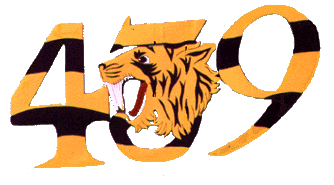|
History
of
 Squadron Squadron
  
Chapter
VI
Winter in the Netherlands
November 1944 January
1945
After four days of fairly clear skies no one was surprised when the weather returned to "normal" on 28 December with a combination of heavy fog and ice covered roads and runways that forbade flying. The weather did not stop the V.1s , however, and loud
"whoomphs"
punctuated the day and night.
Christmas had come and gone,
"just like any other working day."
There had been one good party a few days in advance, when the officers entertained the airmen of the squadron. The central mess had been specially cleaned and modestly decorated for the occasion,
and a well stocked bar kept "whistles wet" while the gang sang their way through F/O Mickey Harrison's anthology with F/O Walt Kubicki beating out the rhythm on the piano.
|
Intentionally
left blank
|
Intentionally
left blank
|
In honour of the occasion F/O Lyal Shaver composed a special squadron song, but alas! the words have not been recorded. An enemy Me. 410 tried to liven things up on Christmas morning by making a strafing run across the maintenance section at the Eindhoven airfield; the
bullets hit only frozen ground. After voicing profane objections to this interruption of their slumbers, the airmen poured scorn on the German's eyesight. With the rows of aircraft
"standing out like sore
thumbs", it was difficult to understand how he could have scored a complete miss. The officers' mess was rather deserted that
day, because of operational requirements, but in the airmen's mess there was
"the real Christmas touch" with a bounteous dinner which, in the traditional manner, was served to them by the officers.
Clearer skies in the morning of 29 December enabled the squadron to send out three missions, two of which saw considerable action and excitement. As their recent battle area south of Aachen was completely closed in, the first formation headed eastward to their old hunting ground around
Coesfeld. F/O Jack Sweeney, leading Red
section, found a train, but when the pilots dived to attack they met a hail of flak which damaged the leader's aircraft and forced him to turn homeward.
|
|
Continuing the recce farther northward, Blue section led by S/L Crosby came upon
"a nest" of trains.
"Bing" himself accounted for five locomotives and Bob Laurence added two more, while at least four freight cars were also damaged. As Bob pulled up and looked around for more targets he noticed, off to the north, a dogfight between an FW.190 and a Typhoon which ended with the British aircraft spinning into the ground and bursting into flames.
Accompanied by his number two, WO
S.A. Church, Laurence gave chase to the Focke Wulf and was closing in when about ten more enemy fighters came down on the two Typhoons. Bob called for a break as the Huns opened fire and then,
with about five of them sitting on his tail, he dived for the deck. Against such odds it seemed futile to try to fight it out. For ten miles or so the chase continued, the enemy pilots firing almost continuously at the violently evading Tiffie.
Then they all broke away except one
"extremely persistent" long nosed 190. Laurence began a series of very tight steep turns close to the ground, hoping that the Focke Wulf wouldn't be able to stay with him. For
some moments it did; then suddenly the fighter "flicked, recovered, flicked again and hit the ground upside down, bursting into flames. Very much relieved, I orbitted the e/a burning on the ground. My relief, however, was short lived for during the orbit I was bounced by an Me. 109 which I had not seen. I immediately started turning with the e/a and had no difficulty getting on his tail. Then I dropped 20 degrees of flap and tightened the turn. I was just
preparing to lay off deflection when the e/a did one complete turn of a spin from 200 feet, hit the ground and burst into flames."
In his combat report for this double victory Laurence remarked that the enemy pilots appeared to be aggressive.
After the initial attack by the ten enemy fighters Bob had lost touch with Church and when the latter did not return it was presumed that he had been shot down. WO Church had completed 21 sorties during his two months with the squadron and had only returned from leave a few days before he went missing. Five months later the squadron was relieved to learn that he had
"cheated fate" on this occasion, escaping with burns and an injured hand. While in prison (1) camp his promotion to a commission came through.
(1) Church was the sixth pilot missing on operations in December the heaviest casualties suffered in any one month during the
war.
  
Copyright
©1998-2016 Michael T. Melnick. All rights reserved
the
unofficial homepage of  Tiger
Squadron Tiger
Squadron
.
.
|
|